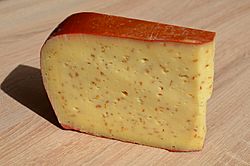Leyden cheese facts for kids
Quick facts for kids Leyden cheeseLeidse kaas (Dutch) |
|
|---|---|
 |
|
| Country of origin | Netherlands |
| Region | Leiden |
| Source of milk | Cows |
| Pasteurised | Yes |
| Texture | Hard |
| Fat content | 30–40% |
| Weight | 3 kg (6.6 lb) to 9 kg (20 lb) |
| Certification | PDO 1997 |
| Named after | Lua error in Module:Wikidata at line 70: attempt to index field 'wikibase' (a nil value). |
Leyden cheese, known in Dutch as Leidse kaas, is a special type of cheese from the Netherlands. It's a semi-hard cheese, meaning it's not super soft like cream cheese, but also not rock-hard. What makes it unique is the flavor from cumin and caraway seeds.
This cheese is made from cow's milk. You can find it made in big factories or on smaller farms, especially around the city of Leiden where it first came from.
Leidse kaas is the most popular kind of komijnekaas (which means 'cumin cheese') in the Netherlands. It looks round and flat, a bit like Gouda cheese. However, Leyden cheese often has sharper edges on one side and is less rounded on its sides compared to Gouda. It usually has about 30% to 40% fat and can weigh anywhere from 3 kg (6.6 lb) (about 6.6 pounds) to 9 kg (20 lb) (about 20 pounds).
Contents
How Leyden Cheese is Made
Making Leyden cheese is a careful process, especially on farms. Here's how it generally works:
Starting with Milk
First, a small amount of buttermilk might be added to the cow's milk. Then, a special ingredient called rennet is mixed in. Rennet helps the milk separate into solid parts and liquid parts. This mixture is kept warm, usually between 28 °C (82 °F) and 30 °C (86 °F).
Forming the Curd
After about 30 minutes, the milk has turned into a soft, jelly-like substance called curd. The curd is then cut into small pieces using a tool called a harp. It's stirred gently and warmed up to about 33 °C (91 °F) by adding hot whey (the liquid part of the milk that separated).
Adding Spices and Pressing
The curd is then carefully lifted out using a cloth and gently squeezed. This is when the special cumin seeds are added to some of the curd. The curd is then placed into round molds called hoops, usually in three layers. The spiced curd goes in the middle layer.
The cheese is then pressed for about three hours to remove more liquid. After that, it's taken out, flipped over, and pressed again overnight.
Salting and Aging
Finally, the cheese is salted. This can be done by rubbing it with dry salt or by soaking it in a salty water bath called brine. The cheese is then stored in a cool, damp cellar to age. If the outside rind gets too hard, it's washed with whey or salty water to keep it just right.
The Story Behind Leyden Cheese
Leyden cheese has a long history in the Netherlands.
Using Skimmed Milk
In the past, farms in the Netherlands mainly made butter to sell in local markets. Butter had to be made nearby because it would spoil quickly. Making butter left farmers with a lot of semi-skimmed milk (milk with some of the fat removed). This milk wasn't worth much and was often fed to calves.
However, farmers found another use for this milk: making low-fat cheese. Low-fat cheeses could be stored for much longer than full-cream cheeses like Gouda, especially in warmer weather.
The Famous Keys
Farmers near the city of Leiden started adding cumin seeds to their low-fat cheeses. They also used a natural coloring called annatto to give the cheese its reddish color.
The traditional farm-made Leyden cheese from the western part of the Netherlands has a special certification called "Protected Designation of Origin" (PDO) from the EU and UK. This means it can only be called Boeren-Leidse met sleutels if it's made in a specific way in that region. The words met sleutels mean "with keys." This name comes from the city of Leiden's official symbol, which features a set of keys.
See also
 In Spanish: Queso Leyden para niños
In Spanish: Queso Leyden para niños

